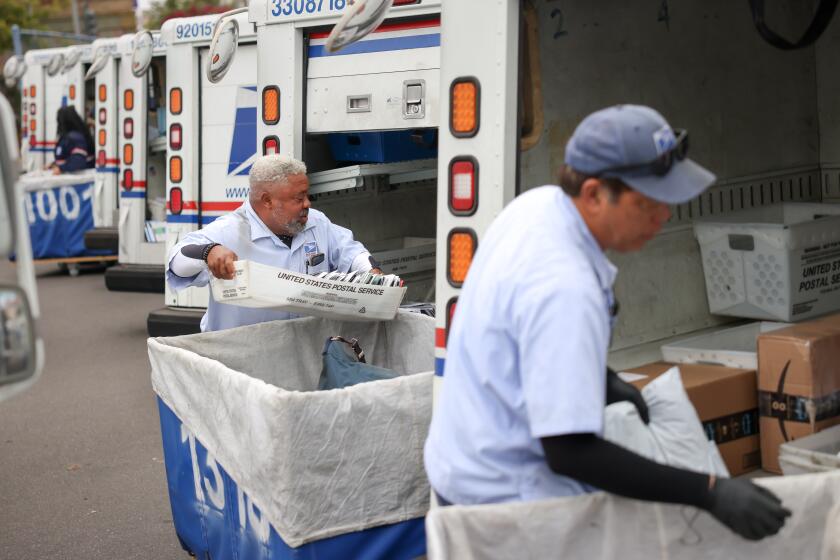Nearly One Month Later, TWA Crash Still a Mystery
- Share via
CALVERTON, N.Y. — Every day after lunch they meet at an old airplane hangar once used to build jet fighters on Long Island, N.Y. They are the brain trust for the worldwide investigation into what happened to Trans World Airlines Flight 800, and each brings his own particular expertise.
James K. Kallstrom briefs the group on developments suggesting that the plane was brought down by a criminal hand. Robert Francis updates those present on the possibility that the Boeing 747 jumbo jet could have exploded from a mechanical malfunction. Rear Adm. Ed Kristensen lays out the latest news from the ocean floor.
For four weeks they have done this and found themselves drawn steadily closer to calling the tragedy the worst terrorist attack in U.S. history. But still they hunt for clues of mechanical failure.
So the puzzle endures. And as the investigation reached the one-month mark this week, three theories remain alive as possible explanations for what happened at 13,000 feet above the Long Island shoreline on the evening of July 17.
If the air crash turns out be a criminal act, the FBI hopes to have much of the preliminary investigative work completed already.
Agents have amassed files from interviews and intelligence data gathered here and abroad. They also are putting together a “freeze-frame” reconstruction of everyone who had access to the aircraft in Athens--the aircraft’s stop before coming to New York--and before it left John F. Kennedy International Airport in Queens for Paris.
“We have a jump-off plan ready to go,” said Kallstrom, an assistant director of the FBI in charge of the New York field office.
Francis, vice chairman of the National Transportation Safety Board, cautioned that too much is unknown to reach a conclusion about the cause.
“I don’t consider myself the least bit frustrated,” he said about the seemingly slow pace of the investigation. “I mean, obviously we would have loved to have something laid on our platter after three days.”
But he noted that “in the history of accident investigations, particularly accident investigations of aircraft that go down in the ocean, this is nothing.”
Here is what has been accomplished so far:
The underwater recovery and salvage operation commanded by the Navy’s Kristensen has recovered all but 29 of the 230 victims, including two more on Thursday. About 50% of the plane’s wreckage has been brought to shore, including Thursday’s retrieval of the last of the four engines.
Sophisticated forensic tests have been performed both here and in Washington. And experts are reassembling the plane’s middle section in the cavernous Grumman hangar, looking for more clues and telltale signs of a crime or an accident.
But with all their brainpower and resources and high-tech wizardry, no golden nugget of evidence has been mined.
Each theory has its own supporters and skeptics. The theories:
A missile.
Investigators have interviewed scores of eyewitnesses who have provided detailed descriptions fitting the signature of a missile. The witnesses recall a streak of light ascending toward the plane. The pilot had just been given permission by controllers to climb higher.
Many of the witnesses have been questioned again and, Kallstrom said, their stories remain credible.
This scenario is supported by radar data that shows unusual activity in the sky off East Moriches, N.Y., that evening. In addition, because of the vast marshy areas of Long Island and openness of the sea, it could have been relatively easy for someone to hide in the grass or on a boat and point a weapon at the Boeing 747.
The initial explosion split the front of the plane in half, a violent blast that could have been the result of an external strike.
Although some experts have argued that more-popular types of shoulder-fired missiles do not have the range to reach the aircraft, authorities said there are about 20 types of missile-firing weapons. Many of the weapons are readily available in the world’s arms marketplaces and capable of hitting the plane at its altitude of 13,000 feet. Some missiles are heat-seeking; others explode near the target; and still others can act as a battering ram to bring down an aircraft.
The greatest source of heat on Flight 800 was its four engines. The three brought in before Thursday have shown no signs of a missile strike.
A bomb aboard the plane.
Some field tests of residue from plane debris initially had proven positive for explosives. But more elaborate examinations at the FBI laboratory in Washington have not confirmed those findings.
Hundreds of people had access to the plane, including passengers, crew members, mechanics, food handlers and other service personnel. Experts often agree that there are holes in security systems at airports here and elsewhere.
Many airport security systems will not detect certain types of explosive materials. For instance, Ramzi Ahmed Yousef, currently on trial in U.S. District Court in Manhattan for plotting to blow up a dozen U.S. jetliners over the Pacific Ocean last year, allegedly assembled a bomb in a test run using such ordinary items as a battery from a portable radio, a Casio watch as a timing device and explosives hidden in a contact lens fluid bottle.
In the test, prosecutors charge, Yousef placed the bomb in a life-jacket pouch under a seat and then left the plane at the next stop. The device later exploded, killing one passenger and injuring several others.
So far in the TWA explosion, the cockpit, first-class seats, front cargo hold and the front galley area--all sections of the plane severed from the main body of the aircraft in the initial explosion--were found to be “unremarkable” for signs of bomb damage.
And as investigators now concentrate on the middle section of the plane and farther to the rear, one large question looms: Could a bomb exploding in the back or middle of the aircraft decapitate its front section?
A major mechanical failure.
Officially, Francis and the NTSB still are in charge of the investigation, and they are pursuing mechanical problems as a possible cause. But Francis has come away with nothing conclusive when examining each critical area.
The NTSB vice chairman said that the cockpit and flight-data recorders provided no clear sign of mechanical failure. In fact, the recorders ended abruptly with what investigators describe as a “fraction of a second sound.” Investigators have been unable to pin down the cause of the sound conclusively.
The plane was 25 years old, and Francis said that federal officials were aware of no significant deficiencies in the aircraft’s structural soundness. A TWA spokesman said that it “met all air-worthiness directives at the time of the crash.”
Service records show a host of problems and repairs indicative of a plane of its age: replacement of engines and repairs of cracks and corrosion. The jet was also forced to make several unscheduled landings.
As investigators continue foraging for clues, the FBI has forgone some investigative steps, such as interviewing the families of the victims. But agents have pushed ahead in other ways, conducting more than 1,500 interviews and attempting to isolate all of the potentially relevant events on the evening of July 17.
That groundwork should give the FBI momentum for a criminal inquiry if investigators determine that the cause was not an accident.
Here at the Grumman hangar, investigators meet and pore over the plane’s wreckage as it is being reassembled on scaffolding. Like the investigation that is moving day by day, this giant skeleton of what was once an airworthy Boeing 747 is slowly coming together.
Each day officials walk alongside the burned, twisted wreckage, again reminded of what happened.
“It’s unbelievable, the tragedy,” Kallstrom said.
More to Read
Sign up for Essential California
The most important California stories and recommendations in your inbox every morning.
You may occasionally receive promotional content from the Los Angeles Times.











